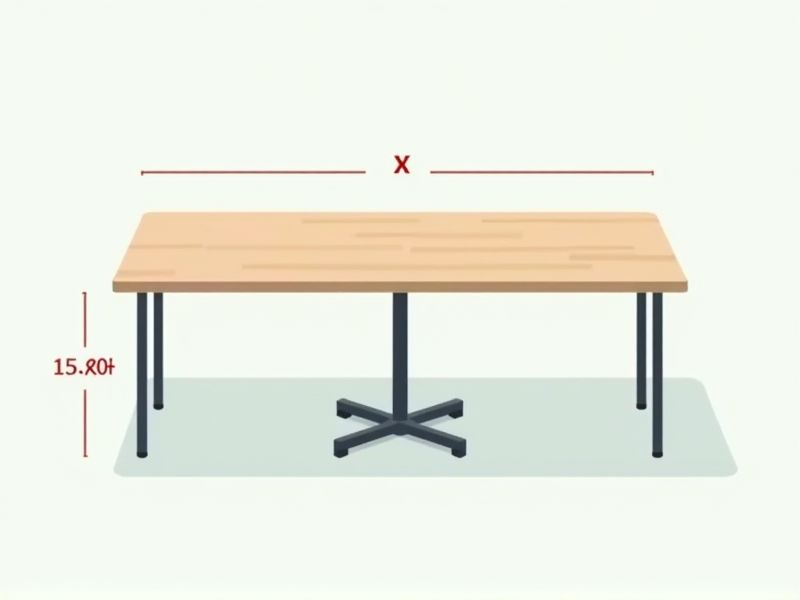
When selecting a table for your space, understanding standard dimensions can help ensure a comfortable and functional fit. Typically, a standard dining table height is around 28 to 30 inches (71-76 cm), which allows for most chairs to slide underneath easily. For seating four people, a round or square table is commonly 36 to 44 inches (91-112 cm) across, while rectangular tables for six people usually measure around 60 x 36 inches (152 x 91 cm). By keeping these typical measurements in mind, you can confidently choose a table size that suits your needs and creates an inviting setting.
Height: 28-30 Inches
The standard height for tables typically ranges from **28 to 30 inches**, making them suitable for various activities such as dining, working, or studying. This height is designed for optimal ergonomics, ensuring comfort while seated in standard dining chairs or office chairs, which usually measure 17 to 19 inches in seat height. When selecting a table, consider the intended use and the chairs that will accompany it to create a harmonious and functional space. Your choice of table height can significantly impact both the aesthetic and comfort of your environment.
Dining Table Width: 36-42 Inches
A dining table width between 36 and 42 inches accommodates comfortable dining experiences for groups. This width allows enough space for place settings while enabling diners to easily reach food and drinks across the table. With a standard length of 60 to 72 inches, tables of this width can seat 4 to 6 people comfortably. Choosing a table within this range ensures both functionality and style in your dining area.
Dining Table Length: 72-96 Inches
A standard dining table length typically ranges between 72 to 96 inches, comfortably accommodating six to eight people. This size not only enhances space efficiency but also allows for adequate room for dishes and decorations. Choosing a dining table within this range ensures your dining area maintains a balanced aesthetic while providing ample seating for gatherings. When investing in a dining table, consider dimensions that align with your space and entertaining needs for optimal functionality.
Coffee Table Height: 16-18 Inches
The ideal height range for coffee tables is typically between 16 to 18 inches, which enables comfortable access while seated. This height allows for optimal interaction with your seating arrangement, ensuring easy reach for drinks and snacks. Many styles, from modern to rustic, cater to this standard, enhancing the overall aesthetic of your living space. When selecting a coffee table, consider how it complements your sofa height for seamless usability.
Coffee Table Width: 18-24 Inches
The ideal width for a coffee table typically ranges from 18 to 24 inches, ensuring it complements your seating arrangement without overwhelming the space. A table within this width range provides adequate surface area for drinks, books, or decorative items while maintaining comfortable accessibility. When selecting your coffee table, consider the height, ensuring it aligns well with your sofa or chairs, ideally between 14 to 18 inches lower than the seating. This optimal size not only enhances functionality but also fosters an inviting living area for family and guests.
Desk Height: 28-30 Inches
A standard desk height typically ranges between 28 to 30 inches, making it suitable for most individuals when seated. This height range ensures optimal ergonomic support, allowing your elbows to rest comfortably at a 90-degree angle. For individuals taller than 6 feet, a height-adjustable desk might provide the necessary flexibility for better posture and comfort during extended work hours. Investing in a desk within this height specification can enhance your productivity and overall well-being.
End Table Height: 20-24 Inches
The standard height for end tables typically ranges from 20 to 24 inches, making them ideal for placement beside sofas or chairs. This height allows for convenient access to items such as lamps, drinks, or books while seated. Choosing an end table within this range ensures that it complements the surrounding furniture and enhances the overall aesthetic of your living space. When selecting an end table, consider your specific seating arrangement to ensure optimal functionality and comfort.
Conference Table Width: 48-60 Inches
A standard conference table typically spans a width of 48 to 60 inches, offering ample space for collaboration among participants. This width accommodates comfortable seating arrangements, ensuring each individual has enough room to engage in discussions effectively. You can enhance your meeting experience by selecting a table that not only fits this dimension but also complements your office's aesthetic. For larger groups, opting for a width closer to 60 inches can facilitate better interactions and visibility among attendees.
Console Table Depth: 12-15 Inches
When selecting a console table, consider a depth ranging from 12 to 15 inches for optimal functionality and aesthetic appeal. This dimension allows the table to fit snugly in narrow spaces without overwhelming the area. Typically, console tables are used in entrances, hallways, or living rooms, where they can serve as decorative displays or functional storage. By choosing a model within this depth range, you ensure that your choice is not only stylish but also practical for everyday use.
Kitchen Island Height: 36-42 Inches
A kitchen island height typically ranges between 36 to 42 inches, catering to both comfort and functionality. For standard countertop height, 36 inches is ideal for food preparation and meal service, aligning with most kitchen standards. However, if incorporating seating, consider a height of 42 inches to accommodate bar stools, enhancing your kitchen's social atmosphere. Ultimately, selecting the optimal height enhances ergonomics and usability in your cooking space.
